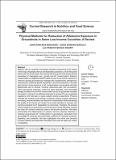| dc.description.abstract | Aflatoxin (AF) is a powerful carcinogen primarily produced by some strains
of the fungus Aspergillus flavus and Aspergillus parasiticus, which frequently
infest nuts and cereal crops. Groundnuts are among the most widely studied
substrates of Aspergillus spp., growth and AF contamination. Aflatoxin
contamination is a significant public health concern since chronic exposure is
linked to causing carcinogenicity, teratogenicity, hepatotoxicity, estrogenicity,
neurotoxicity, childhood growth impairment, and immunotoxicity in humans
and animals. Acute exposure to AF contamination is associated with fatal
aflatoxicosis due to nausea, vomiting, abdominal pain, and convulsions.
Good agricultural practices, control of plant diseases, and favourable
storage conditions can limit AF contamination yet do not guarantee complete
elimination. Looking for an effective technique to reduce AF to an acceptable
regulatory limit has been a great subject among researchers. Physical
methods like manual visual sorting, screening, density, roasting, dehulling,
winnowing, and decortication can reduce AF contamination while maintaining
the quality of the kernel and render the kernels harmless to humans and
animals compared to AF degradation by chemicals. Therefore, the present
review article found that physical removal/visual sorting efficiently lowered
the mean AF content commonly used in low-income countries. We briefly
enumerated the effectiveness of various common physical methods in
reducing post-harvest AF contamination in groundnuts, particularly their
percentage AF reduction and outsort/loss, sufficient AF reduction evidence,
feasibility, and scalability. We also highlighted the merits and demerits
of these methods and essential information that could be helpful for further
investigation | en_US |

